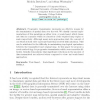ICCSA
2011
Springer
13 years 8 months ago
2011
Springer
Progressive transmission represents an effective means for the transmission of spatial data over the web. We classify current implementations of this paradigm as either view- or s...
JDCTA
2010
13 years 11 months ago
2010
In spatial clustering, the scale of spatial data is usually very large. Spatial clustering algorithms need high performance, good scalability, and are able to deal with noise and ...
CORR
2011
Springer
13 years 11 months ago
2011
Springer
This paper uses the techniques of spatial data mining (SDM) and change detection (CD) in the field of geospatial information processing. Assuming the feasibility of discovering kno...
ADBIS
2010
Springer
13 years 11 months ago
2010
Springer
Integration of spatial data into multidimensional models leads to the concept of Spatial OLAP (SOLAP). Usually, SOLAP models exploit discrete spatial data. Few works integrate cont...
FSKD
2010
Springer
14 years 2 months ago
2010
Springer
Uncertainty is the intrinsic property of spatial data and one of important factors affecting the course of spatial data mining. There are diversiform forms for the essentiality an...
EDBT
2010
ACM
14 years 2 months ago
2010
ACM
Spatial data are common in many scientific and commercial domains such as geographical information systems and gene/protein expression profiles. Querying for distribution patterns...
TGIS
2010
14 years 3 months ago
2010
Building on abstract reference models, the Open Geospatial Consortium (OGC) has established standards for storing, discovering, and processing geographical information. These stan...
GIS
2010
ACM
14 years 3 months ago
2010
ACM
Many Web sites support keyword search on their spatial data, such as business listings and photos. In these systems, inconsistencies and errors can exist in both queries and the d...
EDBTW
2010
Springer
14 years 3 months ago
2010
Springer
Spatial data warehouses (SDW) rely on extended multidimensional (MD) models in order to provide decision makers with appropriate structures to intuitively analyse spatial data. Se...
TKDE
2002
14 years 4 months ago
2002
Spatial data mining is the discovery of interesting relationships and characteristics that may exist implicitly in spatial databases. To this end, this paper has three main contrib...



